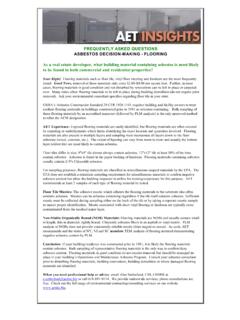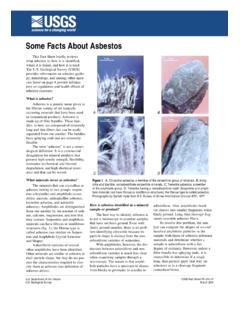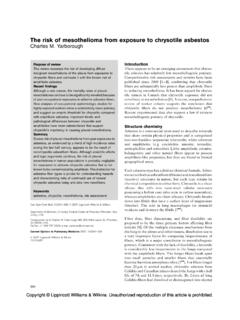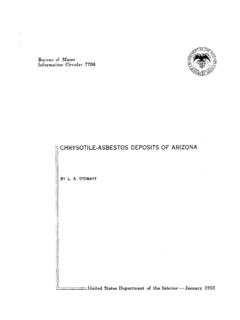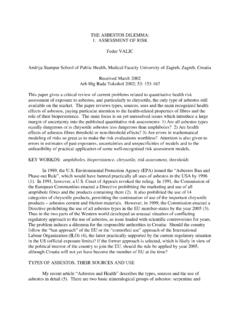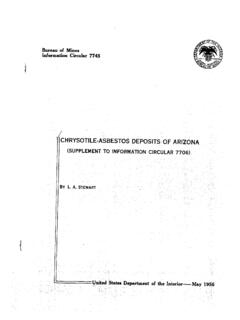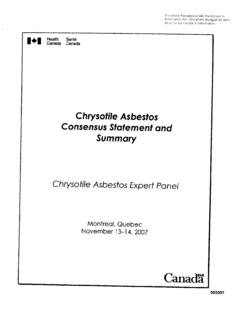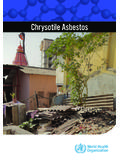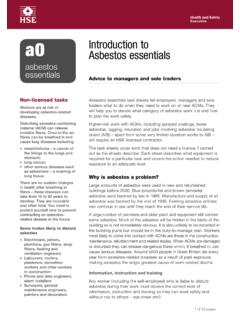Transcription of CHRYSOTILE ASBESTOS FACTS
1 1 CHRYSOTILE ASBESTOS FACTS The following FACTS represent knowledge concerning CHRYSOTILE ASBESTOS , the only form of ASBESTOS currently marketed. fact 1 For the past two decades, CHRYSOTILE has been the only commercially mined form of ASBESTOS being mass marketed. It has constituted over 95% of all ASBESTOS marketed over the past century. The latest data show global use of CHRYSOTILE is around 2 million metric tons per year (USGS, 2013). fact 2 CHRYSOTILE is frequently found contaminated with amphibole forms of ASBESTOS , most commonly tremolite (IARC, 2012). However, the UICC Canadian CHRYSOTILE , which has been shown capable of causing disease, has not been found to contain tremolite (Frank et al.)
2 , 1998). fact 3 CHRYSOTILE has been shown to cause asbestosis, lung cancer, mesothelioma and cancers of the larynx and ovary (IPCS, 1998; WTO, 2001; IARC, 2012; WHO, 2014; Collegium Ramazzini, 2015). fact 4 Latest data show the global burden of ASBESTOS -related cancers estimated to be 194,000 deaths per year in 2013, up from 94,000 in 1990 (an increase of over 100%) with a disability-adjusted life-years (DALYs) burden of 3,402,000 up 94% from 1990 and accounting for nearly two-thirds of the burden from all occupational carcinogens (GBD, 2015). fact 5 Currently, at least 55 countries have banned the use of all forms of ASBESTOS (IBAS, 2015). fact 6 No threshold level of ASBESTOS exposure has been established below which all individuals would be risk free of contracting ASBESTOS -related diseases 2 including those exposed to CHRYSOTILE (Royal Commission, 1984; IARC, 1977, 2012; IPCS, 1998; IPCS 2004-2012; Collegium Ramazzini, 2015).
3 fact 7 In 2001 the World Trade Organization reported: The Panel found too that the efficacy of controlled use is particularly doubtful for the building industry and for DIY [do-it-yourself] enthusiasts, which are the most important users of cement-based products containing CHRYSOTILE ASBESTOS . The WTO stated .. we note that the carcinogenicity of CHRYSOTILE fibres has been acknowledged for some time by international bodies. This carcinogenicity was confirmed by the experts consulted by the Panel, with respect to both lung cancers and mesotheliomas, even though the experts acknowledged that CHRYSOTILE is less likely to cause mesotheliomas than amphiboles.
4 We also note that the experts confirmed that the types of cancer concerned had a mortality rate of close to 100 percent. We therefore consider that we have sufficient evidence that there is in fact a serious carcinogenic risk associated with the inhalation of CHRYSOTILE fibres (WTO, 2001). fact 8 Safer substitutes do exist for replacing CHRYSOTILE , thus eliminating the need for use of any type of ASBESTOS in commerce (IPCS, 1998; Harrison et al., 1999; CSTEE, 2002; WBG, 2009; WHO, 2011; Collegium Ramazzini, 2015). fact 9 The International Labor Organization resolved that: (a) the elimination of the future use of ASBESTOS and the identification and proper management of ASBESTOS currently in place are the most effective means to protect workers from ASBESTOS exposure and to prevent future ASBESTOS -related diseases and deaths; and (b) the ASBESTOS Convention, 1986 (No.)
5 162), should not be used to provide a justification for, or endorsement of, the continued use of ASBESTOS (IL0, 2006). 3 fact 10 In October 2013, the International Commission of Occupational Health (ICOH) stated There is sufficient evidence in humans for the carcinogenicity of all forms of ASBESTOS ( CHRYSOTILE , crocidolite, amosite, tremolite, actinolite and anthophylite) (ICOH, 2013). fact 11 On June 4, 2012 the Joint Policy Committee of the Societies of Epidemiology (JPC-SE) after [A] rigorous review of the epidemiologic evidence confirms that all types of ASBESTOS fibre are causally implicated in the development of various diseases and premature death.
6 The JPC-SE Calls for a global ban on the mining, use, and export of all forms of ASBESTOS and further the JPC-SE describes how Similar to the tobacco industry, the ASBESTOS industry has funded and manipulated research to manufacture findings favourable to its own interests. It has set up front organisations claiming to be expert scientific institutes, such as the Canadian CHRYSOTILE Institute, the Russian CHRYSOTILE Institute, and the Brazilian CHRYSOTILE Institute. But, they are, in reality, lobby groups promoting the continued use of ASBESTOS . (JPC-SE, 2014) fact 12 In 2014, a multi-disciplinary gathering of scientists meeting in Helsinki, Finland agreed that all types of ASBESTOS cause cancer in man and In order to prevent the epidemic of ASBESTOS -related diseases from being repeated among workers and communities in the developing world, ceasing the use of new ASBESTOS is essential (Helsinki Declaration, 2014).
7 fact 13 In 2015, the Collegium Ramazzini (CR) reaffirmed its long-standing position that well-documented availability of safer, cost-effective alternative materials exist for ASBESTOS , including CHRYSOTILE . The CR supports both the 2006 World Health Organization (WHO) position to cease using all types of ASBESTOS and the 2014 WHO publication CHRYSOTILE ASBESTOS that all forms of ASBESTOS , including CHRYSOTILE , are causally associated with an increased risk of cancer of the lung, larynx and ovary, mesothelioma and asbestosis and are in line with the recent evaluation by the International Agency for 4 Research on Cancer (IARC). (Collegium Ramazzini, 2015; WHO, 2006; WHO, 2014) fact 14 Labor federations including the International Trade Union Confederation (ITUC), the Building and Woodworkers International (BWI), the IndustriAll Global Union (IndustriAll) representing millions of trade union members worldwide have issued calls for ASBESTOS bans, just transition programs for displaced workers and measures to protect affected workers and communities (ITUC, 2006; BWI, 2014; IndustriAll, 2014).
8 (The next FACTS refer specifically to risks from ASBESTOS -containing roofing products.) fact 15 The recent study by Ferrante et al, 2015 provides strong evidence of an association between pleural mesothelioma and the use of ASBESTOS -cement roofing (OR= , 95% CI to ) and pavement containing ASBESTOS tailings (OR= , 95% CI to ) (Ferrante et al., 2015; Stayner, 2015). fact 16 Acknowledging the human health hazard posed by ASBESTOS and the environmental contamination following the destruction of ASBESTOS -containing products after man-made or natural disasters, the World Bank Group, humanitarian organizations and the United Nations High Commissioner for Refugees have recommended that ASBESTOS -containing materials including ASBESTOS -cement building products should not be used in disaster relief (WBG, 2009; GSC, 2010; UNHCR, 2005).
9 fact 17 Strong evidence exists for the occurrence of non-occupational ASBESTOS -related diseases as a result of domestic or environmental exposure to ASBESTOS ; in particular, among family members living with ASBESTOS workers (NIOSH, 1995; Ferrante et al., 2015; Stayner, 2015). 5 fact 18 For roofing in remote locations, lightweight concrete tiles can be fabricated using cement, sand and gravel; and optionally, locally available plant fibers such as jute, hemp, sisal, palm nut, coconut coir, kenaf, and wood pulp. Galvanized iron roofing and clay tiles are other alternative materials. Substitutes for ASBESTOS -cement pipe include ductile iron pipe, high-density polyethylene pipe, and metal-wire-reinforced concrete pipes.
10 (CR, 2015; WBG, 2011; WHO, 2009) fact 19 The World Trade Organization considers that the evidence before it tends to show that handling CHRYSOTILE -cement products constitutes a risk to health rather than the opposite. (emphasis added) (WTO, 2001). fact 20 The World Health Organizations warns "Continued use of ASBESTOS cement in the construction industry is a particular concern, because the workforce is large, it is difficult to control exposure and in-place materials have the potential to deteriorate and pose a risk to those carrying out alterations, maintenance and demolition. In its various applications, ASBESTOS can be replaced by some fibre materials and other products that pose less or no risk to health (WHO, 2006).
